Interview by Si Barber.
From ballerinas to bullets, you have an incredibly varied body of work which encompasses the best and the worst of the human condition. Despite their apparent extreme differences in the subject matter, is there something in common between them which you look for in an image?
I suppose there’s universality to photographing people. And certainly I think that whether soldier or ballet dancer each has their discipline and a big team behind them. All are working towards a common goal with both defeat and victory at stake. All living with both the fear of potential failure or the exhilaration of success.
So within this, from my perspective, I see both the vulnerable and the superhuman. The highly trained and yet all of them ordinary son’s and daughters. They have all this in common and I mean all this. It’s a lot, so my job is to convey the sheer effort and commitment that is the out of the ordinary of what they do.
Some of your projects require access being granted at a high level, particularly when it comes to visiting conflict zones. How do you manage this - is it down to networking or more formal approaches?
It’s a combination of both - almost all my work has initially come from word of mouth. After that yes, for certain places you need approval from a high level, based on references and experience. As a rookie photographer I was given the opportunity through a friend to shoot Julius Caesar, an opera at The Sydney Opera House. This was the 1990’s, we were still shooting in film and so far from a guaranteed success. But it was and I went on to shoot 45 more operas for them. When I returned to London in the 2000’s the person who had been running the opera was now running the English National Ballet and so because of my track record he was able to open that door for me. A few years later he went on to become the CFO of the Royal Albert Hall and so further opportunity was granted though this combination of relationship, performance and approval at an increasing level. This by any standards is an epic 25 year relationship, but I think the point is things don’t usually happen overnight. Yes we all need a lucky break every now and then, and damn well make the most of it, but after that reputation and experience count for a lot.
With conflict zones and the David Nott Foundation, this was an introduction to David by someone who knew I had proven myself in hostile environments. But it still takes someone with proper authority to sign things off. A trip is being planned as we speak to the West Bank, and in this case our hosts required CV’s and references before permission was given for me to travel – again a combination of reputation and experience.
After that there is trust - trust that you are able to bring home the photographs needed while always respecting and taking the whole team’s safety and security into consideration at all times.
Documenting conflict zones like Somalia and Iraq requires a strong personal vision. How do you cultivate and sustain your creative perspective when faced with the raw realities of war?
I try not to have too much of a creative agenda before I leave on a trip, though it is often the case that one’s client is very much after a specific image to help tell the story they are focusing on. Typically I don’t do work that involves me being actively shot at, I am more usually dealing with the ‘raw’ face of individual human stories. Without doubt the honestly and reality of these moments are enough to both cultivate and sustain any creative direction I require. So often one is given the strength and perspective from the actual people you are there to document, it is their resilience and dignity even their pain that should (and does in my case) give the knowledge and direction needed.
Have you found that any skills acquired working in combat zones to be transferable to less mortally dangerous but still tricky areas such as the ballet world – I imagine there are some considerable egos to be negotiated?
Yes, there are very often egos in the areas in which I work. Not just dancers, also successful businessmen and women, at the top of their game. I find patience; manners and gentle humour usually soften most hard edges. Emotional intelligence goes a long way; indeed it is an essential skill for photographers in the ‘people business’. Knowing how your equipment works (you should be in unconscious automatic mode) is only the first tiny step in understanding how to capture the essence of what is going on in front of you.
As an embedded photographer in Iraq, you worked alongside military forces. How do you maintain your artistic independence while operating within the constraints of such structured environments and oversight by those who are looking to influence your interpretation of events?
It is true to say that when you’re embedded you are in a situation where you’re probably only being shown the things they want you to see. It is often discussed that this can be a problem where intellectual independence is so vital. But it’s not just that you may be getting skewed information, just as distracting in a dangerous environment is when your hosts are also your protectors. You feel a strong loyalty to these people and therefore not motivated to present anything negative about them. In the end however you can only shoot what is in front of you. My father brought me up on Cartier Bresson with his creative imperative to compose your photograph with the maximum balance of light and form allowed within the four walls of the frame. This is what I think of first, the structural and emotional beauty of the image; because I believe that is the part I can play.
Apart from the physical dangers, working in such areas does not come without a potential impact on one's mental health. This is acknowledged for most NGOs and charities, but less so for journalists, especially freelancers. Have you any advice for photographers working in such areas which will help them manage the upsetting scenarios they may encounter?
Many of us find one of the hardest things when reporting on people in dreadful situations is that both they and you know that afterwards you can just get on a plane and fly home, leaving them with their suffering after you’ve got what you needed. It’s your job, your glory, and the praise you get for being brave. Some egos justify it as ‘telling the story for the world”, and some of their subjects even agree with them… But I can just say that in my case the feeling never quite leaves me and I feel great guilt. My answer, whatever you’re going through is to talk it out with good friends when you get home. Not too much and not with too many, but don’t try and work it out by yourself.
The other thing I do is try to stay in touch with the handful of people I really connected with and who helped me while in their country. Let them know they’re not forgotten. This is particularly the case after my visits to Ukraine last year. Whatsapp is a fantastic means of communication and you can send an instant message of love and support that my friends out there tell me they appreciate a lot.
You work with the David Nott Foundation – an organisation that trains medics in some of the most dangerous places in the world like Syria and Libya. How is such work different from work embedded with military forces, and how do you convey the idea of hope in such desperate situations?
So much about conflict feels brutally and depressingly futile, and mostly you can only do the little bit you are there to do. With the David Nott Foundation half my job is to interview the people I photograph. I ask them what techniques they’ve learned and to tell me specific and tangible examples of how it has helped them save lives. These stories come without hesitation and it is these interviews which end up on the DNF website alongside the portraits and training that show there is always hope. Their words and the expressions on their faces confirm all you need to know that the skills they have been given have enabled them to do their jobs more effectively.
You recently joined Bob Seely MP to Ukraine to take photographs for his book The New Total War which documents the impact of the Russian invasion. Bearing in mind it is a conflict on the European land mass in a well developed country did you find it a different experience to other conflicts you have witnessed?
One of the soldiers we spent time with said that one of his greatest fears was that he worried that the ‘outside world’ thought, “…Ukrainians were just like Russians and so why did the invasion matter..?” That all Eastern Europeans were somehow an infighting basket case and so just let them get on with it. Another described being dominated by Russia was ”…like being a child growing up with a violent and sexually abusive uncle, then when you came to leave he swears he’ll pursue you until he’d completely destroyed you..”
I mention these two instances because it struck me that Ukrainian people have been generationally prepared for this moment for a very long time. They are Europeans like us, they know freedom and prosperity that looks and feels much like ours. That is what is different. Alongside this they’re so strong, so ready, so organised and resourceful. So you leave Ukraine with a head and heart bursting with admiration at the same time burning with fury at the pointlessness, miserable ugliness of the invasion.
Your work in Ukraine is being exhibited at Dimbola Gallery on the Isle of Wight from August 2025 in conjunction with the book launch. For those of us unable to make the journey is there any chance of seeing the work online?
My work will be up in the Dimbola Gallery from 1st of August for a month and after that we are hoping to bring it to London to exhibit alongside the various talks that Bob and I will be doing in association with the publication of his book. This is all still rather in the conceptual stage however, so if EPUK has any ideas I will be very open to them!
Finally, your humanitarian work has captured human perseverance in crises. What advice would you give photographers on developing a distinctive voice while covering conflict with sensitivity?
In the words of Panoushka, the female sniper on the cover of Bob Seely’s book. She told me that whenever she needs to find her centre while lying hidden and motionless for days sometimes weeks at a time, she always asks herself these three questions -
See more work by Annabel Moeller





